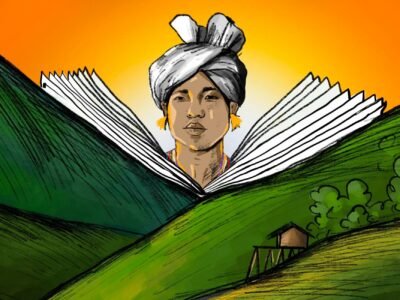
アリ・カジーム 『Shah-Savar(仮訳 : 名騎手)』 顔料、ワスリ紙 72cm x108cm
2021年にイギリスのオックスフォードにあるアシュモレアン博物館で開かれる予定の個展に向け、現在準備に集中する著名なパキスタン人アーティスト、アリ・カジームは、新型コロナウイルス感染症(COVID-19)の世界的大流行が始まってから、自身の創作に対する大きな変化を何ら、感じていないと語る。しかしながら、世界中の人々の暮らしの大部分に影響を与え続けるウイルスの流行を受け、経済が低迷、あるいは破綻に向かうにつれ、アートの世界は大きな打撃を受けることになるだろうと認める。
46歳のカジームはパキスタンに生まれ育ち、2002年にパキスタンのラホールにある国立美術大学(National College of Arts)でBFA (美術学士)を、2011年にイギリスのロンドンにあるスレード美術学校(Slade School of Fine Art)でMFA (美術学修士)を取得した。現在は、多元的アーティストとしてラホールを拠点に活動し、国立美術大学の助教授でもある。
カジームは幅広い分野とスタイルで創作活動を行うアーティストとして知られ、彼の描くポートレートは、シュルレアリスム的世界観を表現し、力強い色彩を背景に、写実的に人物を描き出すことで注目されてきた。
彼の作品は、2019年に開催されたニューヨークのフリーズ・アート・フェアや、ニューヨークにあるメトロポリタン美術館、また、パシフィック・アジア美術館、大英博物館、オーストラリアのクイーンズランド州立美術館などの、世界各地で開かれた主要な国際美術展や展示会で発表されてきた。
グローバルボイスとのインタビューで、アリ・カジームは、人体への魅力、風景から引き出されるインスピレーション、現在の取り組み、そしてパキスタンのアートで今、私たちが知るべきことについて語ってくれた。インタビューの抜粋は以下の通り。
オミッド・メマリアン(以下OM):あなたは、2002年に人体をモチーフにした作品を描き始めてから、ある意味で人体というものに大変、魅了されてきたように思えます。このことは、ご自身のアートに対するお考えにどのように影響を与えていますか?
Ali Kazim: I think the human body is such a fascinating form. It is complex both in its physicality and as a thematic concern. The body, which is core to performing everyday functions, keeps doing its tasks even most of the time without our conscious knowledge, while it goes through various emotional and spiritual stresses. The figurative works I’ve produced perhaps are glimpses of those moments it goes through.
アリ・カジーム(以下AK):人体というのは大変、興味深い構造をしていると思います。人体の外形的特徴や、それを主題として扱うことの双方の意味合いにおいて奥深さがあるということです。日常生活のあらゆる面で基盤となる人体は、様々な感情・精神的ストレスを受けながら、意識せずとも、常にその恒常性を保ち続けます。私のフィギュラティブ(形象的)な視点から生み出される作品は、人体を通して経験した何気ない瞬間を切り取ったものと言えるかもしれません。

アリ・カジーム 『Untitled (仮訳 : 無題、遺跡シリーズ )』水彩絵具、紙 206cm x 460cm 2018年
OM:あなたの作品の中で、歴史的な風景からインスピレーションを受けて制作した作品と、人体をモチーフにした作品との間には、あなたが絵を描く際に用いる技法や、作品に込める思いといった双方の観点から、何らかの関連性はありますか?
AK:I wanted to make some portraits or images based on human figures. I wanted to start with my own explanations, but at that point I didn’t really know where to start until I came across a replica of the Priest King (a small, white, lo- fired steatite statue from the Indus Valley civilization) at Lahore museum.
That is probably the earliest example of a portrait that has survived in this part of the world. It gave me a reason to make sketches of it and then a portrait of the Priest King. I developed a new body of work from there. I wanted to create tales by placing one or two elements next to the portraits, whether it was a prayer cap, a parrot, or a shaving razor.
I fell in love with the watercolor wash technique. I was gradually discovering the possibilities of constructing the images by adding thin layers of colored washes, removing extra pigment from the surface and rendering it with tiny brushes. I guess in that way the formal aspects of the work became important for me.
In early 2013 I started visiting the excavated Harrapan sites near my hometown. The Ruins series landscapes are based on the mounds of the Indus Valley civilization. I think they are in a way collective portraits of the people who may have lived there. I was more interested in these sorts of historical connections.
AK:私は人の輪郭からイメージを膨らませてポートレートや風景を描き出したいと思っていました。自分なりの解釈で紙に向かいたかったのですが、その時点で、何から始めてよいのか全く分からなかったのです。ところが、ラホール博物館で偶然、プリースト・キング (インダス文明期に低温燃成で作られた小型の白い凍石の像)のレプリカを見かけました。
それはおそらく、この地域で発掘された最古の例となる像でした。ですから、何としても描き起こして、プリースト・キングのポートレートを作成するという使命感に駆り立てられたのです。ここから私の新たな一連の作品が展開されました。たとえば礼拝帽やオウム、剃刀(かみそり)といったものであれ、画面の構成要素として1つか2つ、人物の横にオブジェを配置し、物語を描き出したいという思いがありました。
水彩画で用いる技法に魅せられました。絵具のウォッシュ(淡彩)により、薄く色を塗り重ね、表面から余分な顔料を取り除き、細い筆を使い分け再現することで表現の可能性を少しずつ掘り起こしていきました。ある意味では、作品の形式的側面が私にとって大切になりました。
2013年の初め、私は故郷から近いハラッパー遺跡に通うようになりました。一連の作品である「遺跡」で描かれている風景は、インダス文明期の丘陵からインスピレーションを得たものです。ある意味では、かつて、その空間で生活を営んでいたであろう人々の集団的ポートレートのように思えるのです。私はどちらかというと、こうした歴史的なつながりに一層、ひかれました。

アリ・カジーム 『Topi Walah II(仮訳 : 帽子を被る男性 II)』顔料をワシリ紙に加圧して印刷 50cm x 75cm
OM:あなたは国際的にとてもご活躍されていますね。たとえばメトロポリタンなどの美術館があなたの作品を購入して展示するといったように、世界中の大都市であなたの作品を見ることができます。ラホールやパキスタンのアート界で、あなたの作品はどのように受け入れられていますか?
AK:It’s such an honor that some prestigious institutions around the world have acquired my work over a period of time. I’ve been actively exhibiting in Pakistan since the beginning of my career. I was invited to make a large human hair sculpture/drawing for the first edition of the Karachi Biennale in 2017.
The project was appreciated well; I received the jury’s prize at the very first biennale of Pakistan. Then the next year for the inaugural edition of the Lahore Biennale I made a large installation called “Untitled (Ruins of the lovers temple)” in a public garden with five thousand life-size terracotta hearts.
Towards the end of the biennale, people were allowed to pluck hearts from the walls of the ruins. I later traced this and was surprised to see how people showed so much care for the fragile terracotta hearts they picked up from the site or gifted it to their loved ones. The project is living its new life.
My recent large-scale watercolor drawing “The Conference of the Birds” was exhibited last year in the Karachi Biennale and this year I did two projects for the Lahore Biennale, including a large installation of 3,000 unbaked clay birds at an abandoned brick factory. The installation lasted until the rain fell. The process of the clay birds turning to earth was very beautiful and poetic.
AK:世界中のいくつかの権威ある機関が、私の作品を長期に渡り所蔵してくれることを大変、光栄に思っています。私は、自分のアーティストとしてのキャリアを歩み始めた当初からパキスタンで積極的に作品を出展してきました。2017年に開催された第1回カラチ・ビエンナーレで、私は人の髪をモチーフに線画を描き、それらを立体的に組み合わせ、巨大な髪の毛を表現した作品の制作依頼を受けました。
私の作品は高い評価を得ました。パキスタンで開催された第1回ビエンナーレの審査員賞を受賞したのです。この翌年に初開催されたラホール・ビエンナーレでは『Untitled(Ruins of the lovers temple)「仮訳 : 無題(恋人たちの寺跡)」』と題した大規模なインスタレーションを手掛け、テラコッタ製の等身大の心臓のオブジェ、5000個を公設庭園内に展示しました。
ビエンナーレの最終日に差しかかると、観客は、私の制作したインスタレーション展「恋人たちの寺跡」の会場の壁に取り付けた心臓のオブジェを取り外してもよいことになりました。その後どうなったかをたどってみると、壁から取り外された壊れやすいテラコッタ製のオブジェは大切に扱われていたり、愛する人に贈られたりしているが分かりました。そういったことを知り、私は大変、驚いたのを覚えています。私の作品は、新たな形で生き続けているのです。
私の最新作である大規模な水彩画『The Conference of the Birds(仮訳 : 鳥たちの集会)』は、昨年のカラチ・ビエンナーレで展示され、今年のラホール・ビエンナーレでは、廃墟となったレンガ工場にインスタレーションを展開し、粘土で作った3,000羽の鳥のオブジェを焼成せず展示するなど、2つのプロジェクトを担当しました。展示空間内に置かれた鳥のオブジェは雨が降り始めるまで形を保ち続けていました。鳥のオブジェが雨に打たれ、やがて土へと還っていく一連の様子は本当に美しく、詩的でした。
OM:世界の人々がパキスタンのアートについて知るべきことや期待すべきこととは何でしょう?
AK:Apart from contemporary art, the region has more to offer. There are fascinating cave engravings from the Paleolithic age in the north of Pakistan. The magical terracotta artifacts from the Indus Valley Civilization are amazing. The Gandhara sculptures, which truly are remarkable in their appearance. It’s hard to take your eyes off the Fasting Buddha at Lahore Museum. These Gandharan sculptures in many ways are the first examples of the earliest form of globalization.
It is fascinating to see how a new genre of sculpture developed when the Indo-Greek styles emerged. Then the Mughal miniature paintings are a visual treat. The two main cities, Lahore and Karachi, have successfully held two editions of the biennales each year since 2017. That has started a new era, with local people getting a chance to see some amazing works from Pakistani and international artists. This year the Lahore Literary Festival’s dates overlapped with the Lahore Biennale towards the closing week.
AK:現代アートとは別に、この地域にはもっと多くのものがあります。パキスタン北部には、旧石器時代の魅力的な洞窟壁画があります。インダス文明の魅惑的なテラコッタの人工遺物は、驚くほど素晴らしいです。ガンダーラ彫刻のその姿形は、まさに目を見張るものがあります。ラホール美術館の即身仏から目を逸らすことなどできません。これらのガンダーラ彫刻は、いろんな意味で初期のグローバル化の最初の例と言われています。
インド・グリーク様式が出現した頃に彫刻の新しいスタイルがどのように育まれたのかということを知るのは興味深いことです。ムガール時代のミニチュア絵画は、私たちの目を喜ばせてくれます。2017年からラホールとカラチの2大都市で2年に1度、ビエンナーレ展が開催され、地域の人々にパキスタン、並びに国際的なアーティストの素晴らしい作品を見てもらう機会となり、新しい時代の幕開けを告げるものとなりました。今年のラホール文学祭の日程は、ラホール・ビエンナーレの閉会日の週にかけて重なりました。

アリ・カジーム 『Untitled(仮訳 : 無題)』 水彩絵具、紙 30cm x 35cm 2018年
OM:あなたの創作で最も影響を与えたアーティストは?
AK:There are many artists I admire very much. I am completely in love with Doris Salcedo, Kiki Smith, Louise Bourgeois, Cornelia Parker, Robert Gobber, and Vija Celmins’ work. I have just realized that most of my favorite artists are female. Their work is much informed, emotionally charged and very intelligently made with loads of patience. I think everything is there. They have produced immaculate works over the period of time.
My works on paper technique owe much to the Bengal School’s watercolorists. I’ve learned a lot by observing their paintings that are in public collections in Lahore, and have also seen some in Delhi.
AK:尊敬してやまないアーティストはたくさんいます。例えば、ドリス・サルセド、キキ・スミス、ルイーズ・ブルジョワ、コーネリア・パーカー、ロバート・ゴバー、ヴィヤ・セルミンスといったアーティストの作品に心酔しています。今気づいたのですが、私の大好きなアーティストのほとんどが女性ですね。彼女たちの作品は、根拠に基づく解釈で感情豊かに、そして非常に知性的なアプローチによって忍耐強く制作されています。非の打ちどころがありません。彼女たちはずっと、完璧な作品を生み出してきました。
私が紙に絵を描く際に用いる技法は、多くをベンガル派の水彩画家から学んだものと言えます。私は、ラホールに収蔵されている彼らのパブリック・コレクションの作品を注意深く見て多くを学びましたし、デリーでも何点か見ています。
OM:美術学校は、アーティストを生み出したり養成したりするものではありません。だとすれば、個々の学生の芸術的才能を伸ばすといった点に関して、現実的に美術学校に期待できるものとは、どういったものでしょうか。
AK:I think art schools provide an environment where one tests ideas and talks about them with the fellow striving young artists. Some of them will continue studio practice; others will advance in related fields such as art writing, curation, galleries, art fabrication etc. They also can create their own circle of creative people while going to the school. Schools offer graduates the ability to showcase their best to the world and take chances. They get connected with the art world. These are important steps to practically enter the art world.
AK:美術学校は、努力に励む若い芸術家たちと共に、アイデアを試し、意見を交わす場を提供してくれると思います。彼らの中にはアトリエで研さんを積み続ける人もいます。一般的には、アート分野の執筆、学芸員、ギャラリーへの勤務、アート制作などの関連分野に進みます。また、学校に通いながら、クリエイティブな仲間を集めて独自の輪を作ることもできます。美術学校での様々な経験によって、卒業生は、渾身の作品を世界へと発信し、チャンスを手にする機会が増えるのです。アートの世界につながっています。これらは実際にアートの世界に足を踏み入れるための重要なステップなのです。






